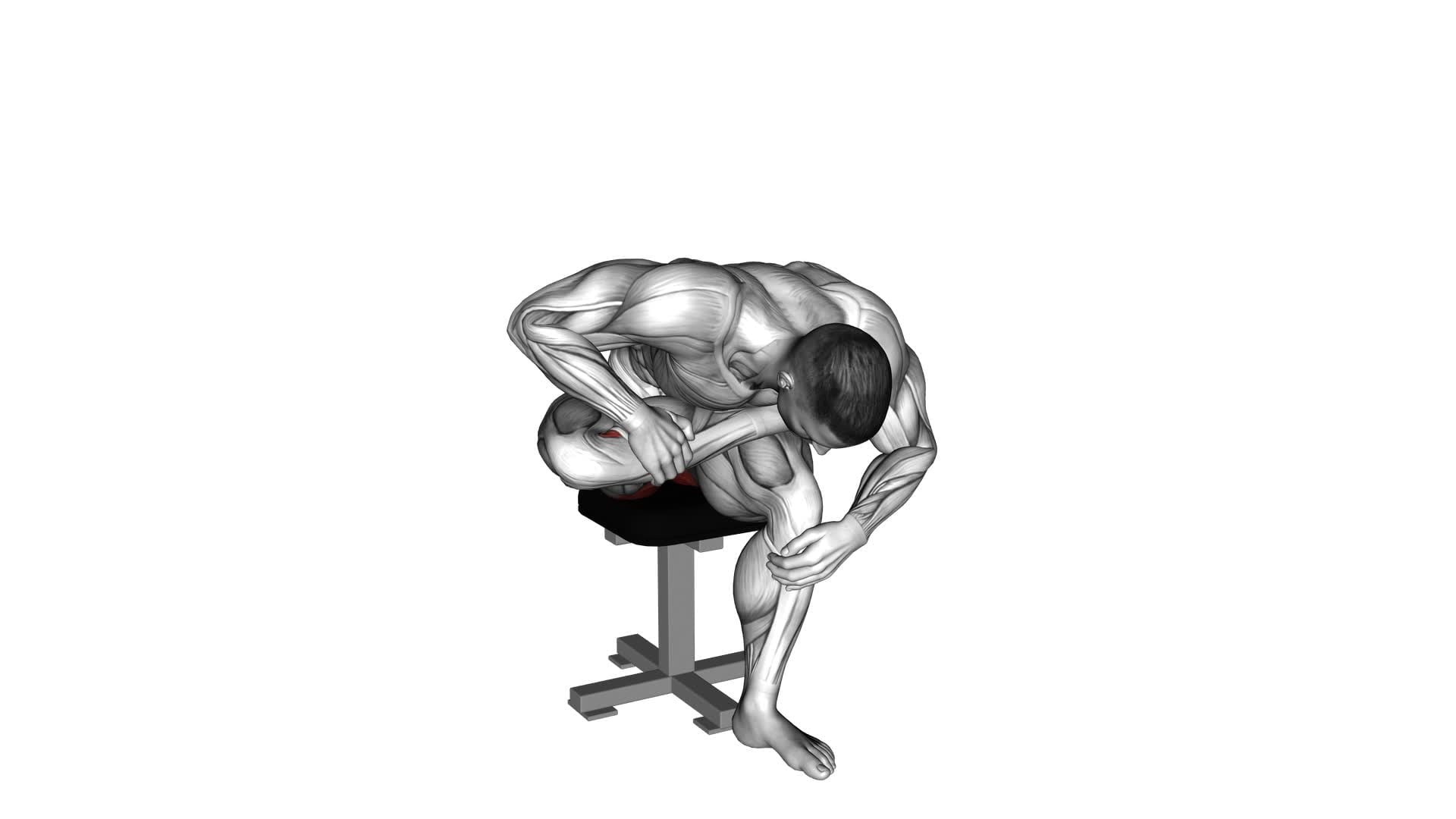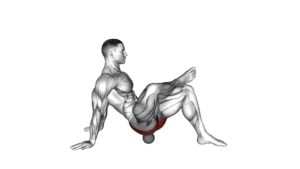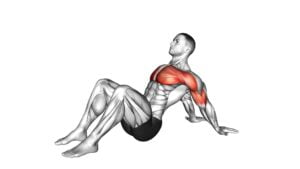Seated Piriformis Stretch – Video Exercise Guide & Tips

Are you looking for a quick and effective way to stretch your piriformis muscle? Look no further! In this video exercise guide, we'll show you how to properly perform the seated piriformis stretch.
Watch This Exercise Video
Whether you're a beginner or an advanced practitioner, we've got modifications for everyone. Avoid common mistakes and learn valuable tips to incorporate this stretch into your routine.
Get ready to feel the benefits of the seated piriformis stretch in just a few minutes a day!
Key Takeaways
- The seated piriformis stretch improves hip flexibility and increases range of motion in the hips.
- It helps alleviate tightness in the hips and relieves tension in the glutes and lower back.
- The stretch can prevent piriformis syndrome and help alleviate sciatica pain.
- Proper form and technique, along with modifications and precautions, are important for safely and effectively performing the seated piriformis stretch.
Benefits of the Seated Piriformis Stretch
The seated piriformis stretch offers numerous benefits for improving hip flexibility and reducing muscle tightness. Flexibility is crucial for maintaining proper joint function and preventing injuries. By regularly performing the seated piriformis stretch, you can increase the range of motion in your hips and improve overall flexibility.
One of the significant benefits of this stretch is its ability to prevent piriformis syndrome. This condition occurs when the piriformis muscle, located in the buttocks, becomes tight or inflamed, causing pain and discomfort. By stretching the piriformis muscle regularly, you can prevent it from becoming tight and reduce the risk of developing piriformis syndrome.
Additionally, the seated piriformis stretch helps alleviate muscle tightness in the hips, which is common for people who spend long hours sitting or have a sedentary lifestyle. Tight hips can lead to lower back pain and limited mobility. By incorporating this stretch into your routine, you can release tension in the hips and improve overall muscle flexibility.
Proper Form and Technique
To ensure effective execution of the seated piriformis stretch, it's essential to maintain proper form and technique throughout the exercise. One common misconception is that you need to force your body into a deep stretch. However, this can lead to injury and isn't recommended. Instead, start by sitting upright with your back straight and your feet flat on the ground. Gently cross your right ankle over your left knee, making sure to keep your right foot flexed. Then, slowly lean forward from your hips while keeping your back straight, until you feel a gentle stretch in your right glute. Hold this position for 15-30 seconds, then switch sides.
There are also variations and progressions you can try to increase the intensity of the stretch. For a deeper stretch, you can use your hand to gently press down on your right knee, increasing the stretch in your glute. Another option is to perform the stretch lying down on your back, with your legs crossed and your knees bent. This can provide a different angle of stretch and target the piriformis muscle from a different position.
Now that you understand the proper form and technique for the seated piriformis stretch, let's move on to discussing modifications for beginners and advanced practitioners.
Modifications for Beginners and Advanced Practitioners
To modify the seated piriformis stretch for beginners, try using a cushion or folded towel under the hip of the extended leg to provide additional support and comfort. This modification helps alleviate any discomfort or strain that may be felt in the hip area. The cushion or folded towel acts as a prop, allowing you to ease into the stretch gradually. As you become more comfortable with the stretch, you can gradually reduce the amount of support provided by the cushion or towel.
For advanced practitioners, you can deepen the stretch by bringing the extended leg closer to your body. This will increase the intensity of the stretch on the piriformis muscle. You can also try experimenting with different angles and positions to target different areas of the muscle.
Remember to listen to your body and never push past your limits. It's important to find a balance between challenging yourself and maintaining proper form.
By incorporating these modifications, both beginners and advanced practitioners can customize the seated piriformis stretch to their individual needs and abilities.
Now let's move on to the next section, where we'll discuss common mistakes to avoid when performing this stretch.
Common Mistakes to Avoid
Avoid these common mistakes when performing the seated piriformis stretch to ensure proper form and maximize its effectiveness. Here are four common mistakes to watch out for:
- Rushing the stretch: Take your time and hold the stretch for at least 30 seconds on each side. Rushing through the stretch can limit its benefits and increase the risk of injury.
- Not maintaining proper posture: Keep your back straight and your shoulders relaxed throughout the stretch. Avoid slouching or leaning forward, as this can diminish the stretch's effectiveness.
- Overstretching: While it's important to feel a stretch, pushing too hard can lead to strain or injury. Ease into the stretch and stop if you feel any pain. Remember, a gentle stretch is more effective than an aggressive one.
- Neglecting to breathe: Breathing deeply and rhythmically during the stretch helps relax your muscles and allows for a better stretch. Avoid holding your breath, as it can cause tension and limit the stretch's effectiveness.
By avoiding these common mistakes and practicing proper technique, you can ensure that you're getting the most out of the seated piriformis stretch.
Now, let's move on to the next section for tips on incorporating this stretch into your routine.
Tips for Incorporating the Seated Piriformis Stretch Into Your Routine
To effectively incorporate the seated piriformis stretch into your routine, try performing it at the beginning or end of your workout. This stretch targets the piriformis muscle, which is located deep in the buttocks and can become tight or inflamed, causing pain and discomfort. By stretching this muscle regularly, you can improve flexibility, reduce muscle tension, and alleviate any associated pain.
There are several variations of the seated piriformis stretch that you can try. One variation involves crossing one ankle over the opposite knee, then gently pressing down on the raised knee until you feel a stretch in your buttocks. Another variation involves sitting upright with both feet flat on the ground, then crossing one ankle over the opposite knee and gently leaning forward until you feel a stretch.
When it comes to the duration and frequency of the seated piriformis stretch, aim for holding the stretch for 30 seconds on each side. You can repeat this stretch two to three times on each side, depending on your comfort level. It's important to listen to your body and not push yourself too hard, as overstretching can lead to injury.
By incorporating the seated piriformis stretch into your routine, you can improve flexibility and reduce the risk of developing piriformis syndrome. Remember to start slowly and gradually increase the intensity of the stretch over time.
Happy stretching!
Frequently Asked Questions
Can the Seated Piriformis Stretch Help With Other Types of Lower Back Pain?
The seated piriformis stretch can provide relief for various types of lower back pain. It's particularly effective for sciatica, as it targets the piriformis muscle, which can compress the sciatic nerve. By stretching this muscle, you can alleviate pressure on the nerve and reduce pain.
Additionally, the seated piriformis stretch offers the benefits of increased flexibility and improved circulation, which can help alleviate general lower back discomfort.
How Long Should I Hold the Seated Piriformis Stretch for Optimal Results?
To get the optimal benefits from the seated piriformis stretch, it's important to know the optimal holding time.
Holding the stretch for about 30 seconds to 1 minute can help lengthen and relax the piriformis muscle, reducing tension and relieving lower back pain. This duration allows for a deeper stretch and promotes better flexibility.
Are There Any Precautions or Contraindications for Performing the Seated Piriformis Stretch?
When performing the seated piriformis stretch, it's important to be aware of any precautions or contraindications. Before starting this exercise, it's recommended to consult with a healthcare professional, especially if you have any pre-existing conditions or injuries. They can provide guidance on whether this stretch is suitable for you and if there are any modifications you should make.
Taking these precautions will help ensure a safe and effective stretching routine.
Can the Seated Piriformis Stretch Be Done During Pregnancy?
During pregnancy, it's important to consider the safety of exercises. Is the seated piriformis stretch safe for all trimesters? While it's generally safe, it's important to consult with your healthcare provider to ensure it's suitable for you.
If you're looking for alternative stretches to relieve lower back pain, you can try gentle pelvic tilts or cat-cow stretches. Remember to listen to your body and modify any exercises as needed.
How Often Should the Seated Piriformis Stretch Be Performed to See Improvements in Flexibility and Pain Relief?
To see improvements in flexibility and pain relief, you should perform the seated piriformis stretch regularly. By incorporating this stretch into your routine, you can effectively improve hip flexibility and reduce sciatic nerve pain.
Consistency is key, so aim to do the stretch at least three to five times a week. Remember to listen to your body and adjust the frequency based on your comfort level and individual needs.
Conclusion
Incorporating the seated piriformis stretch into your routine can provide numerous benefits, such as improved flexibility and reduced lower back pain. By following proper form and technique, you can effectively target the piriformis muscle and prevent common mistakes.
Whether you're a beginner or an advanced practitioner, there are modifications available to suit your level of flexibility. Remember to gradually increase the duration and intensity of the stretch for optimal results.
Start incorporating this stretch into your routine today for a healthier, more flexible body.

Author
Years ago, the spark of my life’s passion ignited in my mind the moment I stepped into the local gym for the first time. The inaugural bead of perspiration, the initial endeavor, the very first surge of endorphins, and a sense of pride that washed over me post-workout marked the beginning of my deep-seated interest in strength sports, fitness, and sports nutrition. This very curiosity blossomed rapidly into a profound fascination, propelling me to earn a Master’s degree in Physical Education from the Academy of Physical Education in Krakow, followed by a Sports Manager diploma from the Jagiellonian University. My journey of growth led me to gain more specialized qualifications, such as being a certified personal trainer with a focus on sports dietetics, a lifeguard, and an instructor for wellness and corrective gymnastics. Theoretical knowledge paired seamlessly with practical experience, reinforcing my belief that the transformation of individuals under my guidance was also a reflection of my personal growth. This belief holds true even today. Each day, I strive to push the boundaries and explore new realms. These realms gently elevate me to greater heights. The unique combination of passion for my field and the continuous quest for growth fuels my drive to break new ground.



